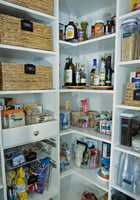5 Signs That You Might Need a Professional Organizer
Inside the Toolkit of a Professional Home Organizer
My husband was telling me the other day about a professional golfer that he likes and what the golfer carries in his golf bag. I frankly couldn’t understand the fascination at first. Then it hit me. I’d like to know what other professional home organizers carry in their bag. So, I thought I’d write a blog about the tools that a professional home organizer uses to do their job in case there is someone who is curious.
Here are some common tools that a professional home organizer might use:
- Label Maker: Label makers help create clear and organized labels for containers, shelves, and other storage solutions. This ensures that items are easily identifiable and can be quickly located. This is a must have item for all professional and amateur organizers. Here’s the one that I use.
- Command Hooks: These can be used just about everywhere, the kitchen, bathroom or closets.
- File Folders and Binders: I like to scan and store as much as I can digitally. For paper organization, file folders and binders are used to sort and store documents in a systematic manner. I like to keep these on hand for when we are sorting through paper with our clients.
- Digital Tools: Organizers might use apps and software for tracking tasks, creating digital to-do lists, and managing client appointments and schedules. My go to is Instacart for when we are on a job, and something is needed in a hurry.
- Trash Bags and Recycling Bins: Essential for decluttering, organizers use these to help clients sort items for disposal or recycling. I use clear ones for donations and black ones for trash. I made the rookie mistake of throwing away donations and donating trash. I’ll never do that again. :)
- Measuring Tape and Level: Precise measurements ensure that furniture, shelves, and other storage solutions fit perfectly within the available space. I use an electronic measuring tape like this one. It’s easy to use and comes in quite handy when I am measuring solo.
- Cleaning Supplies: Cleaning materials such as disinfectant wipes, sprays, and cloths are used to clean and sanitize spaces as items are organized. Microfiber cloths are a must and inexpensive. Pro tip: buy different colored ones and try to always use them for the same purpose. For example, my blue ones are for cleaning glass and my yellow ones are for cleaning countertops.
- Donation Boxes: To facilitate decluttering, organizers often have boxes or bags on hand for clients to separate items they wish to donate or give away. If you don’t have clear bags, I recommend using boxes with the top opened so you can always see what you have inside.
- Notebooks/Pens/Scissors: Organizers use these tools to jot down notes, create plans, and keep track of their progress during organizing sessions. Also, washable markers can be helpful when something needs to be marked though not permanently.
- Sharpie and Sticky Notes: Sharpie’s and sticky notes are two of life’s greatest inventions and quite underrated. We use them for a variety of applications. Sometimes sticky notes are used to write on and sometimes used to visually group like things before organizing them.
- Shelf Pins: When organizing a kitchen or pantry it usually involves adjusting shelves. Sometimes shelves are missing their pins and other times we find a shelf we can use but they have no pins. We carry a variety of shelf pin sizes for these moments.
- Wall Anchors: Every now and then a shelf might come loose, or I might have to hang a new one. I always keep a supply in my bag as backups and just in case I need a one-off.
- Handheld Vacuum: Organizing can be messy. Once we empty out the space we are organizing, we usually vacuum so we can start out with a clean space. For most jobs, a small handheld will do the trick. I use this one.
- Screwdriver: I carry a handheld one with various bits. It is lighter than a drill and easy for me to get into tight spaces. If I am hanging a shelf, I might use a power drill which I keep in my car for emergencies. It’s too heavy to lug around.
- Rubber Mallet: Surprise. Surprise. Not everything fits or separates easily. Sometimes a gentle nudge or a whack is needed. A rubber mallet is gentler than a hammer.
- Step stool: Kind of obvious what it is used for. I like the 3 step one because they are relatively lightweight, and I can sit on the top step when folding clothes or have to do some lower shelf adjusting.
- Furniture Sliders: These are used to move heavy furniture without damaging floors or straining muscles. They used to be called mini movers. They work well and I can move most furniture by myself. Make sure you have plastic bottoms, and the cloth covers when moving on hardwood floors to not damage it.
- Labeling Supplies: Sticky labels, chalkboard labels, Bin clips or markers for labeling containers and shelves to make items easy to find.
- Personal Protection Equipment (PPE): Depending on the situation, organizers might use gloves, masks, and other protective gear to maintain hygiene and safety.
In the world of professional home organizing, each tool has its purpose, contributing to the ultimate goal of transforming chaos into calm. Just as a golfer relies on a well-curated selection of clubs, a home organizer relies on this arsenal of tools to create spaces that are not just tidy, but also functional and harmonious. And when that last-minute need arises, Instacart stands ready to deliver the finishing touch to the organized home.


